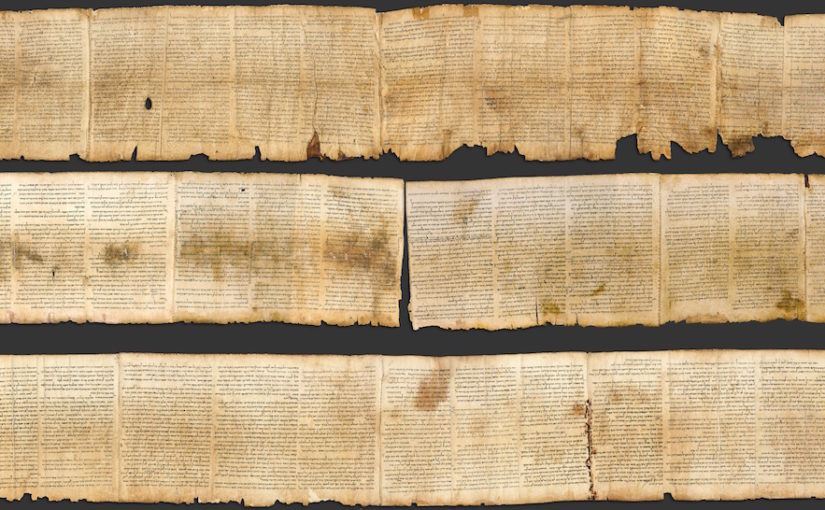Once the contents of the Bible were settled, how was that Bible transmitted from generation to generation so that it has survived until now? Another way of approaching this issue would be to ask, “How certain can we be that the documents in the Bible are faithful copies of the ones written by the original authors? How confident can we be that the text we have is what they wrote?”
Virtually all scholars familiar with the evidence presented by the manuscripts (handwritten copies of the Biblical texts produced before the invention of the printing press) would agree with the five basic statements listed below. They would agree on this basic evidence, but might disagree widely on what the evidence implies.
Five Basic Facts about Manuscripts and Transmission
1. First, a diverse group of scholars—including very liberal ones and even fundamentalist ones who are familiar with the manuscripts—would agree that none of the original manuscripts of any biblical book have survived to the present. What we have are copies of copies of copies, no two of which are exactly identical (except that some of the tiniest fragments may be identical to the relevant passage in a larger manuscript).
2. Second, they would agree that scholars must reconstruct the original texts from the evidence provided by these copies. Such reconstruction work is called Textual Criticism.
3. Their third point of agreement would be that the oldest surviving copies of any of the books of the Hebrew Bible are found among the Dead Sea Scrolls and date from around 150 BCE. Before the discovery of these scrolls, the oldest complete copy of any Old Testament book dated from the 900s CE. The Dead Sea Scrolls, therefore are tremendously important for reconstructing the text of the Old Testament, since they are roughly 1000 years older than the next oldest complete copies.
4. Further, our diverse group of scholars would agree that the oldest complete copies of the New Testament date from the fourth century CE (300’s CE), and 5. that the oldest fragments of any New Testament book date from the second century CE (100’s CE).
A Few Implications of these Facts
Rather than seeing this evidence as a cause for concern, many biblical scholars see the diversity of evidence for the original text as incredibly fortunate. If all of the copies were identical, would we not have to suspect that someone had gathered up the copies at some point and destroyed the ones they thought were wrong? If that had happened we might never be able to evaluate their judgment. As it is, however, it is clear that this was not done. The early churches preserved even those copies that differed from the ones they thought were best. That means that we have an incredible wealth of information from which to work when we attempt to reconstruct the exact wording of the original text. While we may not be able to have total certainty about the wording of some sections of some of the biblical documents, we have better evidence for the wording of the text of the New Testament than for any other document from the ancient Western world.
Manuscript Types and Textual Criticism
Most of our oldest fragmentary copies of the New Testament date to about 200 CE, though one piece containing four verses from the Gospel of John dates from about 125 CE. Our oldest copies of the Hebrew Bible are among the Dead Sea Scrolls, dating from about a century and a half before Christ.
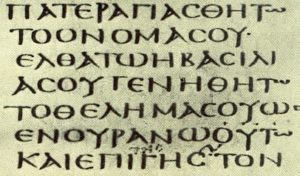
Matthew 6:9-10
The oldest copies of the Christian Bible as a whole, Codex Sinaiticus and Codex Vaticanus, date from the fourth century (300s) CE. These were written on parchment. The parchment copies date from the period after Constantine I (Emperor of the Roman Empire) came to power and encouraged literary productivity. Diocletian had earlier attempted to exterminate Christianity. He had Christian books burned. His attacks help explain why no complete copies of the NT from before Constantine I remain.
After Constantine came to power, Christians pioneered the use of the codex, a group of individual sheets bound together as in a modern book. This system soon replaced the use of scrolls since it was more practical for finding scriptural passages in a codex that in a scroll.
Manuscript Types
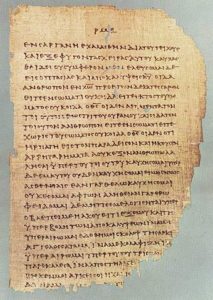
We can divide the available manuscripts into basic types on the basis of the materials used to produce them and the type of writing (orthography) used. The earliest copies of the New Testament books, and perhaps all the biblical books, were written on papyrus, a material that is not very durable. As the communities that used these texts became more affluent they copied them onto parchment—animal skins used for making scrolls that would last many generations. Some of these early parchment copies have survived to the present.
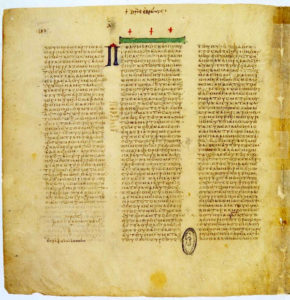
2 Thessalonians 3:11-18, Hebrews 1:1-2:2
The great fourth century codex editions are written in uncial (or majuscule) script—large capital letters written in continuous script with no punctuation or spaces between words. Later manuscripts, called minuscules, are written in small cursive letters, with spaces added between words and individual letters connected to form groups and syllables.
Modern Textual Criticism
How do scholars decide which manuscripts to follow when they produce a new translation of the Bible? Often they use a standard critical text produced by weighing the evidence presented by the manuscripts.
Weighing the Manuscripts
Perhaps the most valuable manuscripts are the early uncials. Codex Sinaiticus and Codex Vaticanus, for example, date from the fourth century and are extremely valuable for reconstructing the text of the NT. While Codex Vaticanus is the older of the two, Codex Sinaiticus is more complete. Two other uncial manuscripts are slightly later: Codex Alexandrinus and Codex Bezae.
In addition to these early uncial copies, textual critics must consult hundreds of fragments, quotations from Church Fathers (2nd-4th century), minuscule editions, and translations into Latin, Coptic, Syriac, etc. Each manuscript must be evaluated to determine its age and reliability. In all, there are over 5000 ancient manuscript copies of parts of the New Testament alone, no two of which are identical, but with the help of modern text-critical tools scholars are able to evaluate them and determine which ones are most reliable.
The Dead Sea Scrolls
The discovery of the Dead Sea Scrolls beginning in 1947 near Qumran provided us with copies of books of the Hebrew Bible about 1000 years older than the ones available before that time.
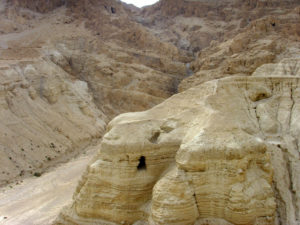
Before this discovery the oldest known complete Hebrew manuscript of the Tanak , Codex Leningradensis, dated from near the year 1000 CE. The Dead Sea Scrolls were produced before the destruction of Qumran in 70 CE and many of them may date back as far as 150 BCE.
The manuscript of Isaiah found among the Dead Sea Scrolls differs from Codex Leningradensis only in very minor ways, suggesting that the process of transmission for that particular book was amazingly careful.
Standard Critical Texts
Beginning in the early 16th century, scholars like Desiderius Erasmus attempted to establish a reliable Greek text of the New Testament. In 1881—1882 B.F. Westcott and F.J. Hort published New Testament in the Original Greek. Today there are reliable critical editions of both the Hebrew Bible and the Greek New Testament. These texts are the result of careful, detailed studies of the available manuscripts, and they provide modern scholars with the ability to see the wording of an amazing number of the manuscripts without having to travel to the museums where they are housed.
Translators have a much more reliable basis for their translations than ever before. Many differences between the King James Version (KJV) and the more recent translations stem from the availability of such a well researched critical edition. The text available to the KJV translators was based on far fewer manuscripts.
Concluding Summary
The earliest copies were written on papyrus. As the communities that used these texts became more affluent they copied them onto parchment. Some of these early parchment copies have survived intact to the present.
The oldest copies of some of the books of the Hebrew Bible were among the Dead Sea Scrolls. The oldest complete copies of the NT date from the fourth century CE, though much older fragments are also available.
The diversity of manuscripts allows us to reconstruct the original text with a high degree of accuracy.
